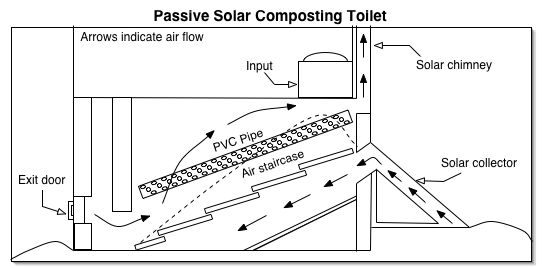 Home HomeAbout Us Visitor Info Photo Gallery Virtual Tour Programs Projects Publications ERAS Contact Us Links |
Passive Solar Composting Toilet
An alternative on-site waste recycling system that reduces pollution and creates safe and nutrient-rich fertilizer for gardens and farms.This Passive Solar Composting Toilet design has been utilized in North Carolina, Georgia, Kentucky, Tennessee, South Carolina, Massachusetts, Maine, and New York. Plans have been sent to several other states here in this country in addition to Peru, Indonesia, the Philippines, Haiti, the Dominican Republic, Mexico, and Australia. The state Departments of Health of North Carolina, Georgia, and Kentucky approve this design, and the state of New York is currently reviewing the plans for approval.

Why Is It Needed?
The typical five gallon flush toilet consumes approximately half of a household's consumption of water. This is about 12,000 gallons of water per person per year to carry 165 gallons of body waste to the place of disposal. The results are:- Large amounts of vaulable and scarce pure drinking water are used
- Ground water and surface water are polluted
- A useful, natural fertilizer is lost
- Energy-intensive and costly waste-treatement plants must be constructed
- The disposal of sewage sludge causes further pollution problems
What Is It?
The waterless composting toilet is an alternative solution to these water pollution problems. It uses no water, thus eliminating massive water consumption used with flush toilets. The self-contained system protects ground and surface waters from contamination, and valuable nutrients are converted into a pathogen-free, sanitary rich humus that can be applied directly to the orchard, ornamentals, and the garden. With solar features, it needs no additional or outside source of energy to complete the decomposition and there are no mechanical moving parts. Because of this, it needs very little maintenance and requires no additional expenses after the original installation. Water conservation equals energy conservation in that no energy is needed to pump, store, or purify waste.Recycling human wastes will also reduce the need for chemical fertilizer production. (Three pounds of composted human feces equals approximately one pound of 10-10-10 commercial fertilizer.)
Composting toilets are a part of an appropriate technology in that they reflect a low-cost solution to local resource management problems. They are simple to build and maintain; and can be constructed from locally available materials.
How Does It Work?
The toilet consists of a concrete block vault with a sloping "air staircase" system (see diagram). The organic wastes move down the staircase at a rate that will ensure aerobic decomposition by the time they reach the final storage chamber. Aerobic decomposition means that the organic materials are breaking down in the presence of oxygen. The compost pile is aerated in three ways: first the incoming air stream is preheated by the flat plate solar hot air collector (eliminating the need for an additional power source), and brought underneath the "steps" of the air staircase so that the air can circulate from the bottom and on up through the pile. Second, the air is conducted thouth the slotted and perforated four inch PVC pipe ducts that run through the center of the pile. Third, air flows over and across the pile, evaporating excess moisture and pulling off the carbon dioxide. The solar chimney drives of the air circulation for the composter by allowing the sun to heat the air in the black vent stack, thus causing a natural draft. The warm air rises by natural convection and in turn pulls more air through the collector and throughout the compost pile, and the cycle goes on.Also, it's important to add after each use a generous scoop of "dry flush" material rich in carbon, such as grass clippings, sawdust, leaves, peat, and/or wood chips. You're building a working compost pile here so you need enough fibrous material to mix with the wastes to keep the pile loose so air can circulate through. All odors are released through the solar chimney which ensures the bathroom is free from odors at all times. The humus that results is only five to ten percent of the original volume as ninety to ninety-five percent will be transformed into carbon dioxide and water vapor and released through the vent. It will take approximately two years for the first decomposition period, then with the continuous process, three to ten gallons of humus will be produced per person per year.
Where Can They Be Applied?
The compost toilet is appropriate for urban, suburban, rural, and vacation-type settings. It is appropriate for recreational and commercial facilities and backcountry camp sites, as well as in residential locations. It can be used seasonally or on a continuous basis in any type of climate.One of the benefits of composting toilet systems is that they can be installed in houses that sit on steep rugged land which would normally be unacceptable for septic systems. This enables good, flat, productive land to be used for agricultural purposes, and marginal land for housing purposes. So utilizing good water conservation technology can also lead the way to the conservation of agriculturally productive land.
Contact us for more information, books, designs, and plans -- including two pages of blueprints and a material construction list with alternative construction details for only $35!!
This project was funded by:
Department of Energy, Region IV
Appropriate Technology - Small Grants Program
Design and labor provided by the staff, interns, and volunteers of Long Branch.
Contact us if you have questions or comments about this site.
© 2005 Long Branch Environmental Education Center. All rights reserved.